Mu Analysis: Are MAPs queer?
The political right tends to think of MAPs (Minor-Attracted People) as the next part of a culture war involving LGBTQ+ rights. The political left often see MAPs as a 4chan hoax, meant to smear LGBTQ+ people. Both sides are mistaken, and in this article, we explain why.
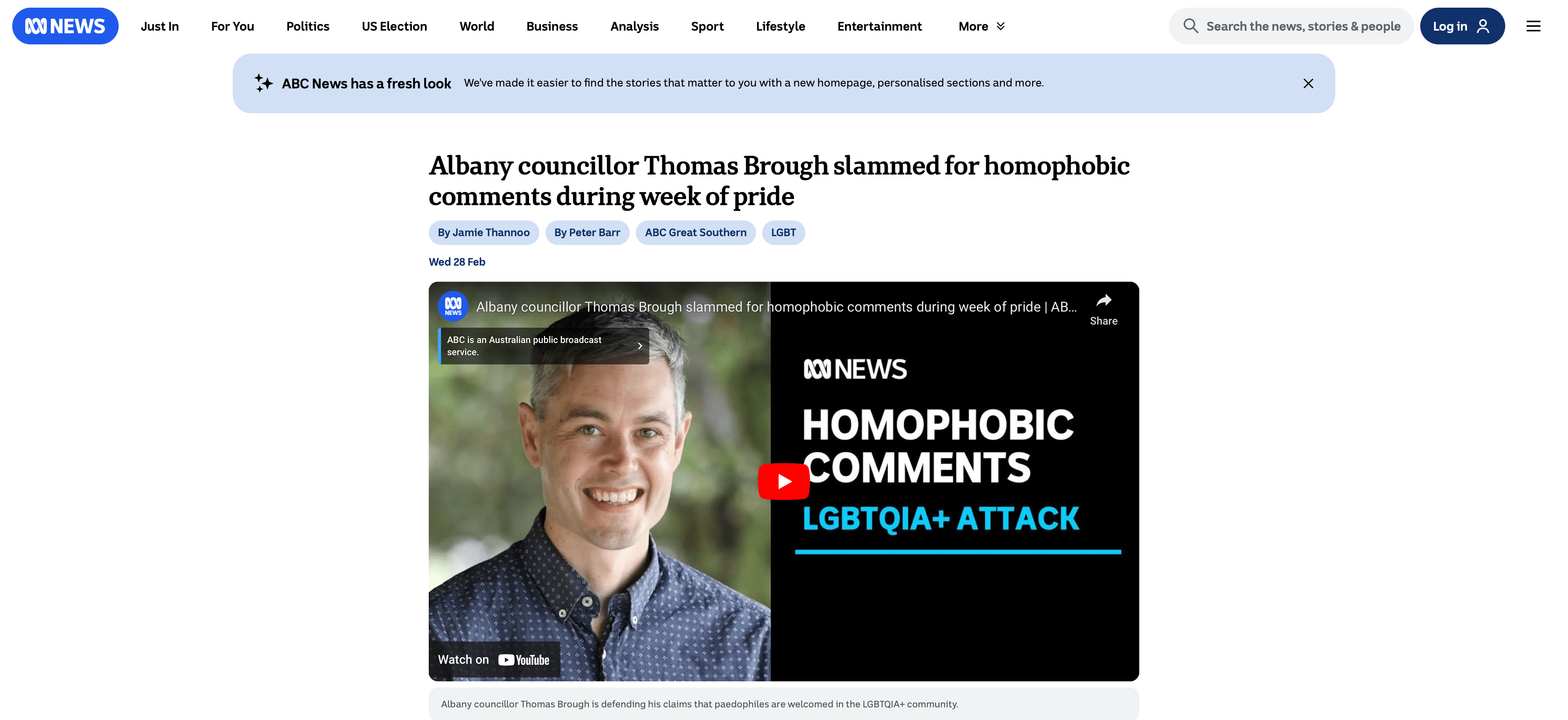
In May this year, Albany councilor Thomas Brough was scolded for saying that the ‘+’ sign in the ‘LGBTQ+’ acronym included pedophiles, too. He thoughtfully told the council meeting "I would encourage people to look into what minor-attracted persons are." Consequently, Brough drew sharp criticism from various LGBTQ+ groups like Albany Pride, that claim such links are entirely fictitious. Following the outrage, he has been requested to undergo 'sensitivity training'.
Modern LGBTQ+ groups are entitled to their own opinion, and MAPs are doubtless distanced by many modern queers. History, however, tells us they are wrong in denying all connections with MAPs. Some of the greatest minds within the queer community were MAPs, or have been neutral or positive towards minor-attraction. The father of the gay rights movement, Harry Hay, was adamant on including groups that promoted the interests of the minor-attracted, such as NAMBLA, into the broader struggle for queer liberation. But this is only one of many such examples of the MAP-gay nexus that, as we shall see, are far too numerous to ignore.
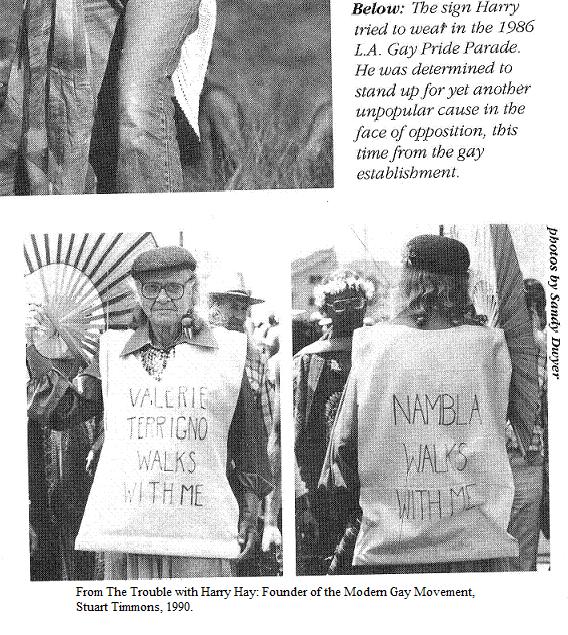
This article will explore the past link between the gay rights movement and MAPs, and seek to clarify whether or not the term 'queer' may be applied to MAPs in the present.
Historical context
Today’s gay rights activists often tout pre-modern examples of homosexuality as proof of its normativity within the human historical continuum. But in doing so, they fail to acknowledge what kind of homosexual relationships were the most frequently recorded, if not the most common. Famed psychologist Bruce Rind has identified one common thread between many of the cultures that tolerated or even celebrated homosexuality; namely, that pederasty was the most common form of homosexuality, or at least the most visible, up until modern times. Indeed, from ancient China, to the Athens and Thebes of classical and Hellenistic Greece, from the Islamic world to Meso-America,[1] pederasty was the default form of homosexuality, something conveniently ignored by today’s queer ideologues. As historian Elise Chenier argued, "For most people, the whole topic is either best avoided, or it arouses such a strong emotional reaction that careful contemplation is quite simply not possible. In countries like the United States, the political climate is such that researchers and treatment practitioners [...] can find themselves subject to censure and their institutional positions endangered."[15]
But what became of that world? We must first look at how the stigmatization of homosexuality began, starting in the Roman empire, where Emperor Constantine prohibited all sexual acts between two individuals of the same sex (pederasty included) after elevating Christianity to the status of an official state religion. This marked a significant chapter in Roman (and to a lesser extent, Greek) cultural history, where pederasty went from a central point in the culture of that civilization, to a taboo and prohibited practice. In particular, the Codex Theodosianus reinforced these attitudes by imposing capital punishment on those found guilty of same-sex activities. This period saw the decline of public acceptance and the beginning of a widespread stigma attached to homosexuality. Subsequently, this attitude would be strengthened by the Catholic church’s growing influence in the medieval period, particularly during periods of unrest such as inquisitions.
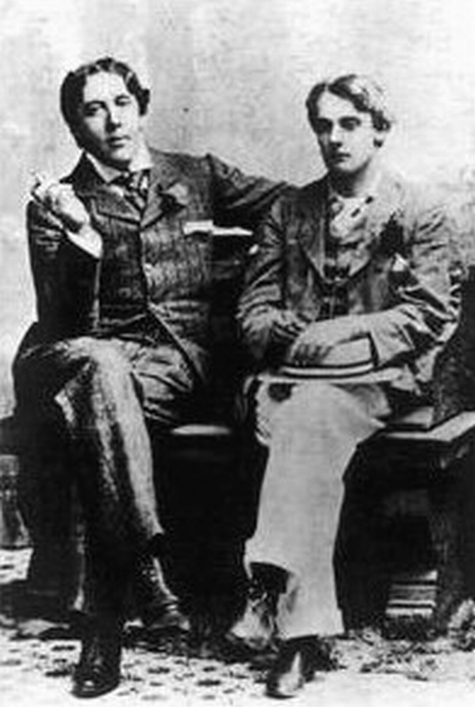
The Enlightenment brought a shift towards scientific inquiry and anti-clericalism, but it did not alleviate the stigma. Early sexologists like Richard von Krafft-Ebing pathologized homosexuality, categorizing it as a mental disorder in works such as his Psychopathia Sexualis (1886). This view was supported by psychoanalytic theories; for example, Sigmund Freud saw same-sex attraction as a developmental issue. Meanwhile, laws in Europe and the US continued to treat homosexual acts as crimes. In Britain, the 1885 Labouchere Amendment led to the infamous trial and conviction of Oscar Wilde. Such laws reinforced public stigmatization and the negative view of homosexuality, as well as minor-attraction, as a deviant condition. Similar attitudes would be exported across the non-western worlds during European colonial expansion, leading to the decline of acceptance in pederastic/homosexual relationships among colonial subjects (such as the various Native American tribes, following conversions to Christianity).
While Alcibiades the Schoolboy (1652) by Antonio Rocco is widely considered "the first homosexual novel" (yet portrays age-gap homosexuality/pederasty), it is widely acknowledged that gay rights activism as we know it has its earliest roots in the 19th century. Many modern queer historians of course choose to ignore the deep pederastic roots of the early movement. The aforementioned Oscar Wilde, who was convicted for his relationship with older adolescent boys, belonged to the Victorian-era artistic group known as the “Uranians”, renowned for its sentimentalization of “greek love” (i.e. pederasty) and challenges against contemporary homophobic attitudes. Such was the groups’ influence that not only did Uranian writer John Addington Symonds[2] introduce the term “homosexual” to the English lexicon via his book A Problem in Greek Ethics (written in 1873 and privately printed in 1901), but the very first American anthology on gay literature – Men and Boys: An Anthology (1924)[3] – is credited to Uranian poet Edward Mark Slocum. Symonds was an inspiration to Walt Whitman, who was himself a famous gay poet and boylover.
In the late 19th century, the German Empire became the cradle of the early homosexual movement, led by pioneers such as Karl Heinrich Ulrichs and Magnus Hirschfeld. Ulrichs, a lawyer and journalist, openly advocated for gay rights in 1867 and died in exile in 1895. Hirschfeld continued this work, founding the Scientific-Humanitarian Committee in 1897 and the Institute for Sexual Research in 1919, which supported homosexuals until its destruction by the Nazis in 1933.[14] Prominent figures like Stefan Zweig, Albert Einstein, and Thomas Mann, supported Hirschfeld’s petition to repeal paragraph 175, which criminalized homosexual acts. Despite these efforts, homophobia surged after the Eulenburg affair (1907-09). Meanwhile, anarchist Adolf Brand launched Der Eigene in 1896 (the first ever homosexual journal), which featured copious amounts of pederastic imagery, and co-founded the Gemeinschaft der Eigenen (GdE) in 1903. The GdE opposed Hirschfeld's "third sex" theory and promoted a more masculine view of male-male sexuality, with some members advocating classical Greek pederasty. French novelist and pederasty/homosexuality defender André Gide agreed. Gustav Wyneken, German pedagogue and writer, was neither to the far-right nor a left-wing extremist, but his influence on educational theory was profound. His ideas of “youth culture” and “pedagogical eros” gave inspiration to movements like the Wandervogel (officially founded in 1901), and Brand’s GdE.[4]
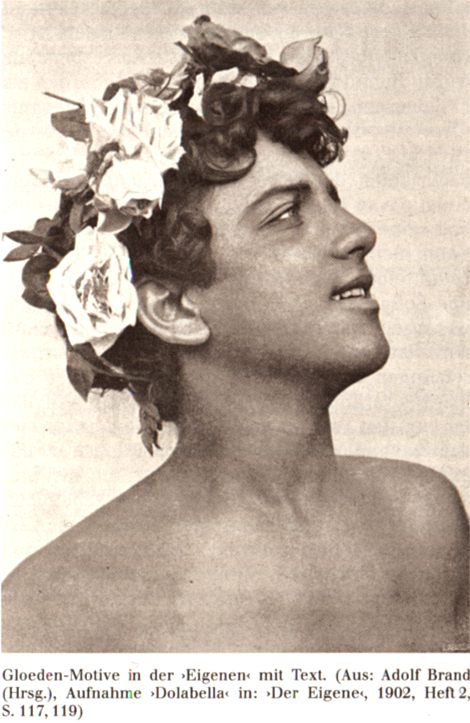
In her book on the once famous and influential pederast, Norman Douglas, Historian Rachel Hope Cleves quotes from Kadji Amin:
According to Amin, “modern pederasty,” which he defines as age-differentiated sex, was the dominant form of male same-sex practice until the mid-twentieth century. As he reminds readers:
Virtually all late nineteenth- and early twentieth-century canonical authors now remembered as “gay” — including Walt Whitman, Oscar Wilde (whose famous “love that dare not speak its name” was pederasty), Marcel Proust, Jean Cocteau, André Gide, Jean Genet, and even James Baldwin — participated in and, in some cases, wrote about age-differentiated same-sex erotic relations.[5]
Indeed, the historical connection between pederasty and homosexuality wasn’t just limited to a distant past, but was intrinsic as far late as the late 20th century, to the point that the history of pederasty can barely be distinguished from the history of homosexuality itself. The post-war gay rights movement of the United States was no exception, with the American Homophile movement leading to the establishment of ONE Inc. in 1952. This organization published ONE Magazine, the nation’s first widely circulated homosexual periodical. The publication, alongside events by the ONE Institute, included discussions on pederasty, exemplified by Dr. Bruno Vitale's contributions. ONE also helped launch The Ladder, the first lesbian rights magazine by the Daughters of Bilitis, founded in 1955 and named after a figure from Pierre Louÿs' The Songs of Bilitis, a Sapphic and pederastic poetry collection. Emerging from a 1952 Mattachine Society meeting, the ONE Institute remains the oldest active LGBTQ+ organization in the US.[6]
The early gay movement, though diverse and often contentious, included age-queer activism. Post-Stonewall, youth groups like New York’s Gay Youth advocated for the elimination of age-of-consent laws. The 1972 Gay Rights Platform called for repealing such laws at the state level,[7] while some groups, including Boston’s Gay Men’s Liberation, radically pushed for the abolition of parental rights and the establishment of communal child-rearing systems. In the UK, London’s Gay Youth Movement also supported age-of-consent repeal, as did the Canadian Lesbian and Gay Rights Coalition, various French queer intellectuals and even the now-lionized international gay rights umbrella, ILGA as late as 1985.
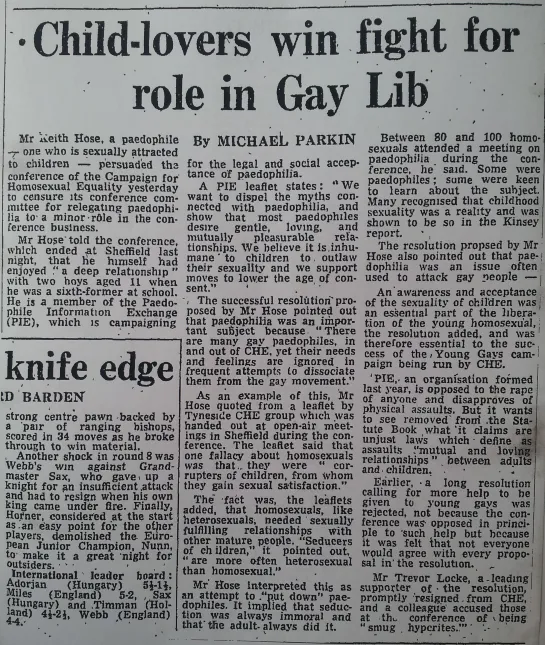
Some of the most prominent gay men of the 20th century shared a strong affection for boys and young men. Alan Turing, the computer scientist who invented the Turing machine and managed to crack Germany's Enigma machine messages in WW2, is one such example. Another is Harvey Milk, the first openly gay man to serve in an American public office, who would eventually turn into a martyr for gay rights following his assassination. Alan Turing, despite his contribution to Britain's victory against Germany, faced chemical castration over his relationship with then-19-year-old Arnold Murray, but before then he was noted as being captivated by young boys, such as when he sponsored a 14-year-old refugee named Robert Augenfeld and would tactfully wait 2 years before he approached the boy. In the case of Harvey Milk, he lost his virginity after an enthusiastic intimate encounter with a gay man back when he was a 14-year-old boy, and he was known to have entered a sexual relationship with runaway hustler Jack Galen McKinley, who had just turned 17 at the time, whilst Milk was 33 years-of-age and served as a father figure/mentor role for McKinley. A personal friend of Harvey's said he "always had a penchant for young waifs," and Milk is alleged to have had sexual contact with people below 15 years-of-age. Notably, the known case of Jack McKinley alone would already make Milk guilty of statutory rape in U.S. states which venerate him (e.g. California) where the age of consent is 18.
And who can forget the co-founder of the Mattachine Society, the man dubbed as the “father of gay liberation”, Harry Hay himself? In his opposition to gay assimilationism, he continued to stand up for MAP rights organization NAMBLA even after the latter’s expulsion from the ILGA in 1994 (contrary to its present-day denial, ILGA was indeed a hotbed of MAP rights advocacy prior to that year) following pressure from the US. That year is a pivotal one, as it marks the formal split between pederasts and homosexuals, ultimately leading to the formation of a nascent MAP rights movement in the 00s and 10s. It followed what we might describe as an explosion of pedophobia in the 70s and 80s across the western world, and for that reason, the split was always destined to be an enduring one. The gay rights movement (presently the LGBTQ+ movement) now tries to distance itself from its own past, engaging in what some may call "rainbow revisionism". This term refers to the erasure of any reference to pederasty in LGBTQ+ history. MAPs might be forgiven for seeing little-to-no reason to re-join a movement that not only "threw them under the bus" for cynical reasons, but can be seen as neo-bourgeois in tendency. Having lost its original aims of class-liberation and challenging entrenched power structures, the community now embraces a new hobby of “passing down” disciplinary processes invested in it by elites, as we will describe later.
Are MAPs Queer?
To get to the bottom of the question of MAP queerness, we must consider what is meant by “queer”, as well as the way society has treated minor-attraction then and now, and how it resembles other queer identities. First, we need to look at what queer theorists such as Gayle Rubin and Michel Foucault formulated as constituting a “queer” identity.
According to Rubin, queerness is defined not only by specific sexual practices or identities, but also by any positioning that challenges the traditional sexual hierarchy. This hierarchy favors heteronormative, monogamous, reproductive relationships while marginalizing others such as same-sex relationships, BDSM, and non-monogamy. Foucault, in The History of Sexuality , argues that sexuality itself is a social construct influenced by power and knowledge. He emphasizes that identities labeled as “queer” resist being boxed into rigid categories and often subvert the norms imposed by society. Queerness thus encompasses identities that defy traditional understandings of sexuality and gender, such as LGBTQ+ identities, but it can also extend to practices or individuals who question binary notions of sexuality and gender norms.
David Halperin, a prominent and historically-aware Queer Theorist sums it up best in Saint Foucault: Towards a Gay Hagiography:
Queer is by definition whatever is at odds with the normal, the legitimate, the dominant. There is nothing in particular to which it necessarily refers. It is an identity without an essence. "Queer," them, demarcates not a positivity but a positinality vis-a-vis the normative--a positionality that is not restricted to lesbians and gay men but is in fact available to anyone who is or who feels marginalized because of her or his sexual practices: it could include some married couples without children, for example. . . . "Queer," in any case, does not designate a class of already objectified pathologies or perversions; rather, it describes a horizon of possibility whose precise extent and heterogeneous scope cannot in principle be delimited in advance.
Thus, any identity that subverts or resists the cis-heteronormative mainstream, including but not limited to LGBTQ+ identities, kink communities, and non-binary gender expressions, can be deemed "queer." Queerness is inherently about challenging established norms, resisting fixed definitions, and embracing fluidity. As recently as 2019, Allyn Walker studied 'The Use of Queer-Spectrum Identity Labels Among Minor-Attracted People', finding varied responses and reasons behind MAPs identifying as 'gay', 'queer', and so on. Walker also noted the history of association between MAPs and other queer communities, penning their article, 'Minor Attraction: A Queer Criminological Issue?' in 2017.
Now, let's consider minor-attraction within western society. It can indeed be described as:
- Unjustly pathologized by society, regardless of what medical authorities have to say about it.
- Oppressed and penalized for merely existing, and in unprecedented ways. An example would be the decades-long sentences over PIM possession, much of it relating to entirely fictional media, and copies of content that has never been used commercially. Another is the existence of the sex offenders registry (SOR), despite the fact that other crimes like robbery, fraud and serious violence[8] have higher rates of recidivism.
- Heavily stigmatized, especially if the attraction is toward pre-pubescent minors. Previously acceptable attractions towards pubescent individuals are increasingly facing the same stigma.
- Said to defy deeply entrenched social and legal norms. Pedophobes of the right-tendency also hold that accepting minor-attraction in any form is a natural conclusion of challenging established norms, especially age-based ones, gender/sexual identity, and the authority of the nuclear family. Placed firmly at the end of the slippery-slope, MAPs are the epitome of social non-normativity.
- At the forefront of challenging societal norms. As seen in the historical overview, MAPs themselves were pivotal in these civil rights struggles, whether they were homosexual or otherwise.
- Fluid and unpredictable. While at any one point in time "minor-attraction" as a term could be said to have a hard boundary, the fluidity of biological age makes it hard to delineate a point at which someone's interests stop being pedophilic and start being hebephilic. The age for the onset of puberty in humans has been decreasing over time, and the fact that some MAPs have broad ages of attraction, and embrace trans-identities such as transage only adds to their queerness.
At the theoretical level, it's safe to say that MAPs are, indeed, queer.
Answering rebuttals
In response to all that has been said above, some modern queers might argue against the existence of queer MAPs as follows:
- Attraction to minors is not a valid sexuality/identity like homosexuality and will never be accepted. A person's age is not a sex or gender.
- Queer sexuality is solely between two consenting adults. So you're not with us!
- Adult-minor sexuality and minor-attraction are inherently harmful, ergo MAPs can never be queer.
All of these points are problematic in that, by trying to distance minor-attraction from the queer identity, they are effectively relying on the same bigoted arguments used to stigmatize adult queer sexuality too. Let's go point by point:
Point 1 is questionable for a number of reasons. Besides the fact that the DSM itself endorses the view of pedophilia and other forms of minor-attraction as being a sexual orientation (and thus holding it distinct from pedophilic disorder which is characterised by distress over the attraction), the distancing of MAPs begs a question. Namely, what is chronophilia if not a secondary spectrum of desires, deserving of its own recognition and identity? Historically ubiquitous[1] age-structured attractions and relations, would need formally categorizing[13] at the very least.
The notion of "valid" and "invalid" sexualities in itself is inherently chauvinistic and appears to be a rehash of the old respectability politics, reminiscent of tactics used by the conservative moral majority of the 1980s and even the Nazi party, which targeted pederasts alongside 'mainstream' homosexuals. Today, some in the LGBTQ community may align with views that pathologize pedophilia and hebephilia as mental illnesses, inadvertently advocating for the respect and care that should nowadays accompany such a label. The punitive brand of carceral psychiatry once imposed on their own community is increasingly unfashionable, in what might now be described as an age of "enlightened tolerance" for mental health. To the contrary, for the Nazis it made no difference whether the homosexual in question was a pederast or a teleiophilic one; both were invalid in their eyes. This raises the question: what truly defines a "valid" sexuality? A genuine answer should avoid relying on ever-shifting societal normativity and must distinguish between attraction and inherently damaging behavior.
Proponents of validity discourse ultimately argue that MAPs, including same-sex-attracted pedophiles or hebephiles, can't be classified as "gay" or "queer." This raises questions about MAPs who are also attracted to adults, and whether or not they can claim an LGBTQ+ identity. The logic can even be extended to minors. If a young teen's attraction isn't adult-oriented, can we even classify them as queer or LGBTQ+?
Mainstream LGBTQ+ liberals often subsequently retort that "age-appropriate" attractions/behaviors exclusively between youth are natural, or normative, implying that preferences will simply "age out", almost as if conveniently mimicking their own western liberal age-grading norms. Yet there is no solid psychological or anthropological evidence that children and teens have an innate and natural preference for their age peers that slowly "evolves" with their own chronological age. There is also no known psychological model for how chronophilic sexual tendencies towards other youth might spontaneously "de-evolve" in adulthood. Indeed, if this were possible, we would have a natural analogue for conversion therapy, a frequent bugbear of the modern LGBTQ+ lobby now reserved mainly for sexual offenders.
Quite contrary to the above nativist argument, proponents of the LGBTQ+ identity have recently taken to pointing out that gender is socially constructed. If we are to accept this at face value, what does it mean for the validity of sexual orientations defined solely by gender, versus those defined by less mutable traits like, say maturity? Is nature itself now invalid?
Taken together, these contradictions suggest that current LGBTQ+ views on socially deviant sexuality may be expediently ignoring complexities in age-structured attractions and their potential legitimacy within broader sexual and gender identity discussions. This, we suspect, owes more to the LGBTQ+ lobby's fashionable, short-term political goals, than the pursuit of truth or integrity.
Point 2 has been partly addressed in our rebuttal to point 1. But to re-iterate, asserting that queerness as a label can only be applied to "consenting adults" constitutes the erasure of the lived experiences of LGBTQ+ youth, both past and present. It could be argued that historical revisionism is a variety of internalized homophobia; i.e. LGBTQ+ people denying part of their cultural identity that does not align with present societal standards.
On the top of that, it should be pointed out how the definition of adulthood as a formal category hasn't always been rigid, as it often changed based on the needs of society and the economy. One doesn't have to look far, to see our point. The Jewish bar/bat mitzvah ceremonies that place adulthood at 14 for boys and 12 for girls, and the curatores system of the Roman empire granted free commoners more freedoms at the age of 30 until it ultimately changed to 21.[9] The age of majority in the 20th century decreased from 21 to 18 across much of the West, and it varies across the world, ranging from 15 in Yemen to 21 in places like the UAE and Puerto Rico. The concept of adulthood is evidently a lot more fluid and socially unstable than most of us will acknowledge, so using adulthood as a benchmark to denote "validity" should be seen by LGBTQ+ people as normatively-biased and reactionary. It should also be noted, based on what queer theorists themselves say, if an identity is not only is non-normative, but actively challenges the status quo, it is queer. Minor-attraction, while supposedly rare, and completely unfathomable in polite society, also challenges common western beliefs on rigidly separating people by age.
By satisfying all of these standards, attraction to minors would appear to be very queer. Perhaps then, it is the gatekeepers of queer identity who need to imagine a new paradigm in which to situate themselves, maybe one more heavily invested in idolizing the institutions of power and seeking "respectability".
Point 3, too, is fallacious. For starters, the term MAP doesn't itself constitute a sexuality. It's an identity label, and umbrella, much like LGBT, or LGBTQ+ are. Whether an identity harms others or not is of course irrelevant to queer identity, yet expert scientific opinions on the harm of AMSC are far less uniform than among laypersons. Recall the Rind report of 1998, which reported its groundbreaking and controversial finding that the majority of adults who had earlier AMSC weren't traumatized, prompting condemnation from Congress, the first of its kind for a peer-reviewed scientific paper. Years later, the same study was replicated, accounting for methodological criticisms, but the results have been consistent, which is a remarkable success for a sociological paper.[10] There is further corroborating evidence beyond Rind, such as Larsen, K. & Larsen, H. (2007), Lahtinen, H., et al., (2018), and Baurmann, Michael C. (1983),[12] indicating that the outlook on outcomes of AMSC is not as bleak as first thought. It's also noteworthy the vast range of evidence showing that the accepted literature on child sexual abuse is plagued with various methodological flaws, including basic ones like assuming causation from correlation alone,[11] making the "scientific" orthodoxy on it that prevails today quite shaky.
In conclusion, the idea that voluntary adult-minor intimacy is inherently harmful is questionable, if not false from an empirical point of view. However, even if we accept the premise that adult-minor intimacy is unethical, that doesn't invalidate the MAP identity itself, as it is based primarily on attraction demarcated by both age and gender.
In short, attraction to minors encompasses a range of chronophilic sexual orientations that fulfill all the criteria of queerness. MAPs can therefore be queer.
Mu is an organization that opposes the stigma on Minor-Attracted People, seeks to enhance their visibility, and pursues reforms to laws that target MAPs without sufficiently protecting children and young people.
Please feel free to discuss this article on our forum thread.
References
- [▲Historical Context] [▲Answering Rebuttals] Rind, Bruce (2013): "Pederasty: An Integration of Empirical, Historical, Sociological, Cross-Cultural, Cross-Species, and Evolutionary Evidence and Perspectives." In: Thomas K Hubbard, Beert Verstraete (Eds.), Censoring Sex Research: The Debate over Male Intergenerational Relations. (pp. 1-90).
- ▲ Symonds, J. A. A Problem In Greek Ethics (via BoyWiki).
- ▲ Slocum, Edward M. (1924). Men and Boys: An Anthology .
- ▲ Neupert, Jutta (1988). "Wyneken, Gustav, Pädagoge". In Benz, Wolfgang; Graml, Hermann (eds.). Biographisches Lexikon zur Weimarer Republik (in German).
- ▲ Rachel Hope Cleves (2020). Unspeakable: A Life Beyond Sexual Morality (p. 6).
- ▲ Dorr Legg, David G. Cameron and Walter L. Williams (1994). Homophile Studies in Theory and Practice.
- ▲ 1972 Gay Rights Platform. Platform created at the National Coalition of Gay Organizations Convention held in Chicago in 1972.
- ▲ Reoffending of adults: Results from the 2007 cohort. Ministry of Justice statistics bulletin.
- ▲ Laes C, Strubbe J (2014). "Minority, majority: youth, divisions of the human life cycle, and Roman law". In: Youth in the Roman Empire: The Young and the Restless Years?
- ▲ Daly, N. R. (2021). Relationship of Child Sexual Abuse Survivor Self-Perception of Consent to Current Functioning.
- ▲ Forouzan, Elham, and Gijseghem, Hubert Van (2005). Psychosocial Adjustment and Psychopathology of Men Sexually Abused During Childhood, International Journal of Offender Therapy and Comparative Criminology, 49(6), 626-651.
- ▲ Yesmap: Research: Prevalence of Harm and Negative Outcomes.
- ▲ Rind (with Richard Yuill - in fact a Queer Theorist) had earlier documented numerous historical and cultural examples of Hebephilic behavior, regardless of whether or not these were homosexual. Ipce has a copy of the full article.
- ▲ Haeberle, E. J. (1981). Swastika, Pink Triangle and Yellow Star: The Destruction of Sexology and the Persecution of Homosexuals in Nazi Germany. The Journal of Sex Research, 17(3), 270–287.
- ▲ Chenier, E. (2011). "The Natural Order of Disorder: Pedophilia, Stranger Danger and the Normalising Family", Sexuality & Culture, 16:172–18 (p. 173). Note also her footnote on the same page:
Historians of sexuality have shown that sexual types, such as homosexuals, pedophiles, and heterosexuals even, are social constructions (Katz 1995). This is to say that the way we understand certain sexual types, indeed, even the notion of sexual types itself, is a product of culture, not nature (Burr 1995). Thus, while it is the case that adults do engage in sex with young children, the meanings we attach to those acts, to their impact on the child, and to the adult who performs or commits such acts, are historically and culturally constructed. This does not mean that such acts do not occur, nor does it mean that they are not experienced as painful for the child. It means simply that there are many ways of understanding these incidences and their consequences; that the way we understand them today is not necessarily any more or less real or truthful than the way they have been understood in different times and places.
